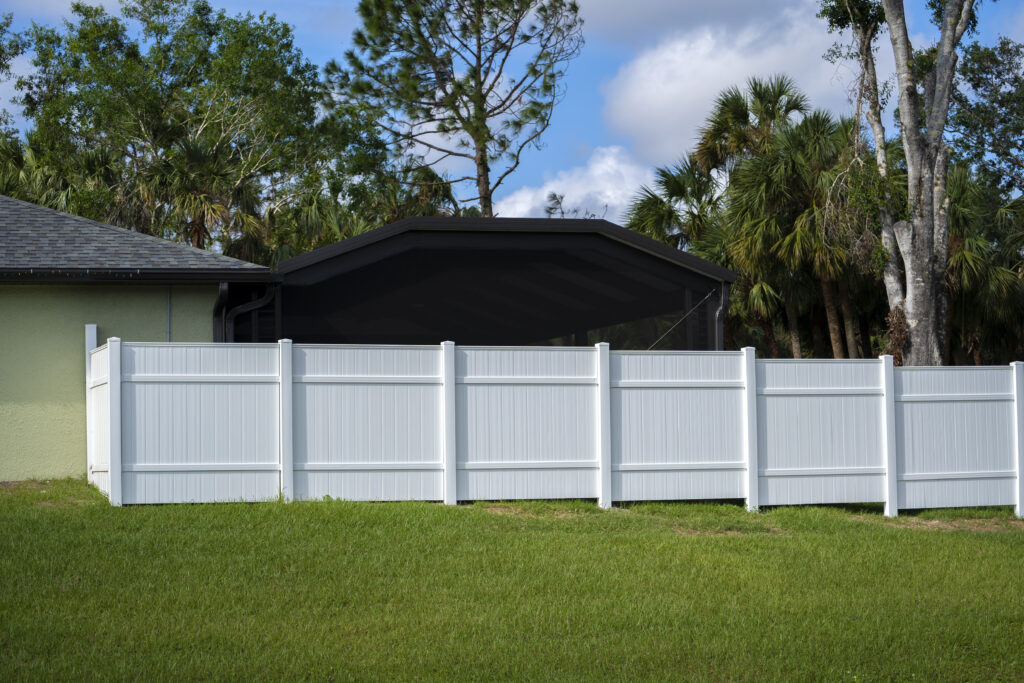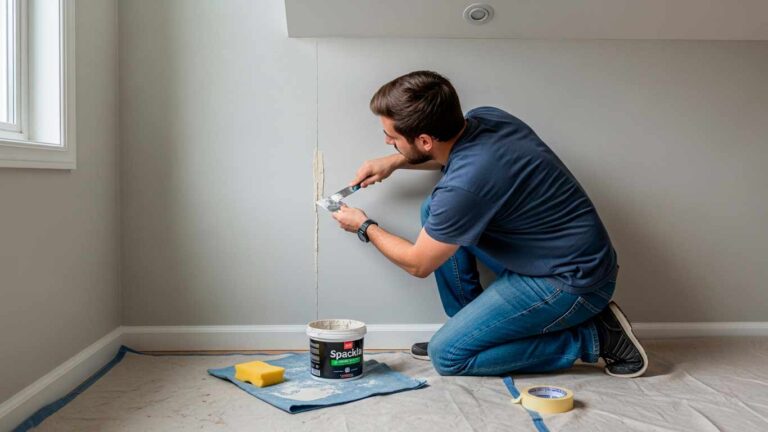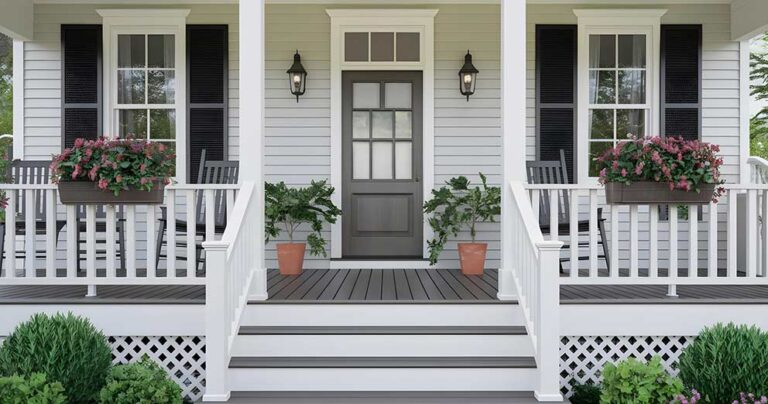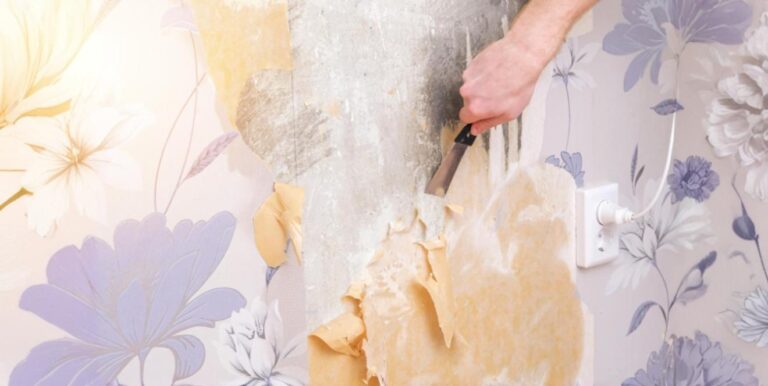Vinyl fences offer homeowners a durable, low-maintenance fencing option with a clean look and long lifespan. But what if you want to change the color? This leads many to ask: can you paint a vinyl fence?
Key Takeaways
- You can paint a vinyl fence, but the non-porous surface requires specialized primers and proper preparation for paint to adhere.
- Proper preparation includes cleaning, scuff sanding, and using a vinyl-specific epoxy-based primer before applying appropriate paint.
- A paint sprayer delivers the most even coat for vinyl fences and helps reach all surface areas.
- Painted vinyl fences need regular maintenance with soapy water cleaning and repainting every 3-5 years.
- Consider alternatives like hanging planters or new fence sections to avoid painting altogether.
- For professional, longer-lasting results, OnDemand Painters offers specialized services for vinyl surfaces.
Vinyl Fence Basics: What You Need to Know
Vinyl fences consist of PVC (polyvinyl chloride) fence material, known for strength and weather resistance. Unlike wood fences that need regular staining, vinyl fences come pre-colored during manufacturing, typically in white, tan, or gray. Most homeowners choose vinyl specifically to avoid the upkeep that wood fences demand, appreciating their low maintenance requirements and resistance to rot and insects.
Can You Paint a Vinyl Fence?
Yes, you can paint a vinyl fence, but it’s not always the best idea. Vinyl’s smooth, non-porous surface makes paint adhesion difficult. Most paint won’t stick well without proper preparation and specialized products. Painting a vinyl fence transforms a low-maintenance investment into something requiring regular upkeep, so consider whether a color change justifies the added maintenance.
Why Homeowners Consider Painting Vinyl Fences
Homeowners think about painting vinyl fences for various reasons. You might have updated your home’s exterior and want the fence to match, or the original color no longer fits your landscape. Sometimes white vinyl fences develop a yellow tint from age or sun exposure. Others purchase homes with existing vinyl fences in colors they don’t like. Understanding the painting process helps you make an informed decision.
Challenges of Painting Vinyl
Painting vinyl comes with unique challenges. The non-porous material gives paint little to grip onto, and temperature changes cause vinyl to expand and contract, potentially cracking paint. Direct sunlight can cause paint to bubble or peel faster. Most paint won’t adhere properly without specialized primers, and the smooth surface resists traditional painting methods. These challenges require specific techniques and materials.
Painting a Vinyl Fence: Step-by-Step Guide
If you’re painting your vinyl fence, start by checking your warranty, as painting may void manufacturer guarantees. Choose a day with mild temperatures and low humidity. Clean the fence thoroughly using a power washer on low setting or soapy water with a soft sponge to remove dirt and debris.
Next, scuff sand the fence to help paint adhere by creating tiny scratches in the smooth surface. Apply a vinyl-specific primer, preferably epoxy-based, designed for non-porous materials. Once dry, apply thin coats of paint, allowing proper drying time between applications for the best finish.
Right Paint for Vinyl Surfaces
Use 100% acrylic latex exterior paint designed for vinyl, urethane-modified acrylic paints, or paint specifically for PVC. Avoid oil-based paints as they don’t expand and contract with vinyl and will crack. Always use an epoxy-based primer before painting to create a surface paint can stick to.
Choose light colors rather than dark ones, as dark colors absorb heat and may cause warping. The right paint can make the difference between a fresh coat that lasts for years and one that peels within months.
Tools Needed for Painting Your Vinyl Fence
You’ll need cleaning supplies (power washer or garden hose, soft sponge, mild soap), fine-grit sandpaper (220 grit), application tools (paint sprayer ideally, or quality brushes/rollers), drop cloths, vinyl-specific primer, and appropriate paint. A paint sprayer creates the most even coat and reaches all areas of the fence, though brushes and rollers designed for smooth surfaces can work too.
Application Techniques for an Even Coat of Paint
Apply primer evenly and let it dry completely. A paint sprayer provides the most consistent finish. Apply thin coats rather than thick ones, as thick paint is more likely to crack and peel on vinyl. Allow each coat to dry completely before adding another, applying at least two coats for durability. Work in sections for the smoothest finish and use painter’s tape for clean lines around hardware or adjacent surfaces.
Avoiding Common Mistakes When Painting Vinyl Fences
Common mistakes include skipping surface preparation, not using proper primer, painting in direct sunlight or extreme temperatures, using the wrong paint type, applying coats too thickly, insufficient drying time between coats, and painting over dirt. Avoiding these errors helps your paint job last longer. For professional results, companies like OnDemand Painters specialize in difficult surfaces like vinyl.
Maintenance of Painted Vinyl Fences
Once painted, vinyl fences require ongoing maintenance. Clean periodically with mild soapy water and a soft sponge. Inspect annually for peeling or cracking and touch up damaged areas promptly. Expect to repaint every 3-5 years, depending on climate and sun exposure. Avoid high-pressure washing, which can damage the paint and underlying vinyl.
A painted vinyl fence needs significantly more care than an unpainted one, which typically only requires occasional rinsing with a garden hose.
Alternatives to Avoid Painting Vinyl Fences
If maintenance concerns you, consider alternatives to painting. Replace sections with your preferred color vinyl, add decorative elements like hanging planters or garden art, or install fence accessories like decorative post caps or solar lights. These options change the look while preserving the low-maintenance benefits of vinyl.
Conclusion
Can you paint a vinyl fence? Yes. Should you? That depends on your willingness to take on additional maintenance. Painting a vinyl fence turns a low-maintenance option into one requiring regular care and periodic repainting.
If you decide to paint, proper preparation, materials, and application techniques make all the difference. For professional results without the hassle, companies like OnDemand Painters have the expertise to properly prepare and paint vinyl surfaces. Understanding the process helps you make informed choices about your property’s appearance and the maintenance commitment it requires.
FAQs
Can I use a pressure washer to clean my vinyl fence before painting?
Yes, use a pressure washer on low setting (300-400 PSI) to clean your vinyl fence, keeping the nozzle at least 12 inches away to avoid damage.
Will a wire brush work for scuffing vinyl fence surfaces to help paint adhere?
No, use fine-grit sandpaper (220 grit) instead of a wire brush to gently scuff vinyl surfaces without causing damage.
What type of paint works best on vinyl fences for long-lasting results?
100% acrylic latex paint specifically formulated for vinyl or PVC surfaces works best, especially when paired with a vinyl-specific primer.
How often should I apply a fresh coat of paint to maintain my vinyl fence?
Apply a fresh coat of paint to your vinyl fence every 3-5 years, depending on weather exposure and wear, to maintain its appearance and protection.
How much time should I allow for painting your vinyl fence from start to finish?
Allow 3-5 days for the complete process of cleaning, drying, sanding, priming, and applying multiple coats with proper drying time between each.
Can I use a damp cloth to clean painted vinyl fence surfaces for maintenance?
Yes, a damp cloth with mild soapy water is perfect for routine cleaning of painted vinyl fence surfaces without damaging the finish.
How does a freshly painted fence impact my home’s curbside appeal and how long does it take to cure completely?
A freshly painted fence dramatically boosts curbside appeal with a cohesive look that complements your home, though it requires 7-14 days to cure completely before withstanding normal wear.



















